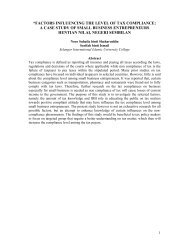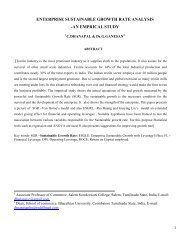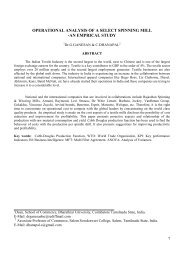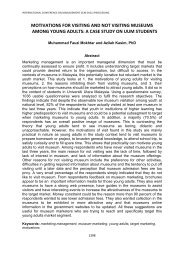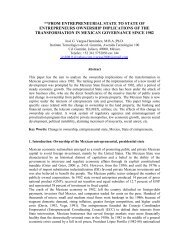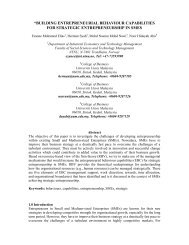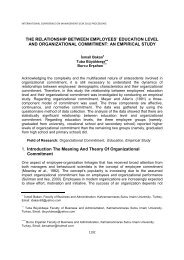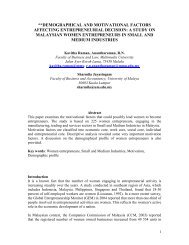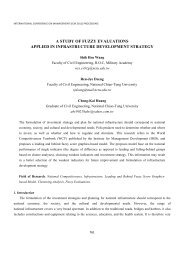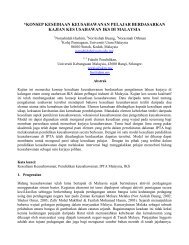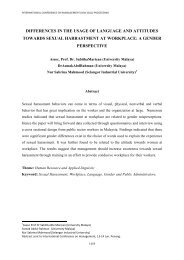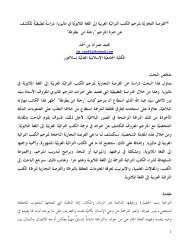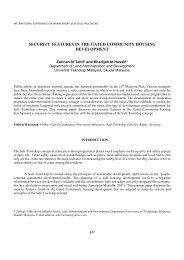2nd ICM 2012 Proceeding - International Conference, Call For Paper
2nd ICM 2012 Proceeding - International Conference, Call For Paper
2nd ICM 2012 Proceeding - International Conference, Call For Paper
Create successful ePaper yourself
Turn your PDF publications into a flip-book with our unique Google optimized e-Paper software.
583<br />
2 nd INTERNATIONAL CONFERENCE ON MANAGEMENT<br />
(2 nd <strong>ICM</strong> <strong>2012</strong>) PROCEEDING<br />
11 th - 12 th JUNE <strong>2012</strong>. HOLIDAY VILLA BEACH RESORT & SPA, LANGKAWI KEDAH, MALAYSIA<br />
ISBN: 978-967-5705-07-6. WEBSITE: w w w . i n t e r n a t i o n a l c o n f e r e n c e . c o m . m y<br />
A MODEL OF ABSORPTIVE CAPACITY IN PUBLIC SECTOR: BASED ON INDIVIDUAL<br />
AND ORGANIZATIONAL COGNITIVE PROCESS<br />
Nader Salehi, Rozeyta bt Omar (PhD) & Kamariah bt Ismail (PhD)<br />
Faculty of Management and Human Resource Development<br />
Universiti Teknologi Malaysia (UTM), 81310, Johor, Malaysia<br />
Snader2@live.utm.my<br />
ABSTRACT<br />
Organization’s environment is dynamic and changing fast. Knowledge-based organization relies on<br />
external knowledge as different type of knowledge that facilitates and improves processes and services<br />
for citizen and stakeholders. A successful organization focuses and looking for new external knowledge<br />
and generate new value. The absorptive capacity is critical capability which leads organization to<br />
successfully innovation performance. This phenomenon achieve new external knowledge for innovative<br />
process in two points. This paper purpose two levels of cognitive structure to identify and evaluate<br />
knowledge which are essential to provide innovation for responsiveness citizen and stakeholders in public<br />
sector. Both levels identify and evaluate knowledge from external sources that depend on their views and<br />
perspectives how they interpret environment. We explain how organization in public sector enhances<br />
innovation performance within absorptive capacity. In this model, prior knowledge, government strategy<br />
and social integration mechanisms are antecedents of absorptive capacity which represent how much<br />
organization successfully able to absorb distant knowledge from environment. Organization culture and<br />
regimes of appropriability also play roles of moderator in this model. These variables interact and play<br />
enforces rules. Absorptive capacity also play role of mediator and finally innovation performance is<br />
consequence in this model.<br />
Keywords: Absorptive Capacity, Innovation Performance, Social Integration Mechanism,<br />
Government Strategy, Prior Knowledge, Regimes of Appropriability<br />
----------------------------------------------------------------------------------------------------------------------------------<br />
1. INTRODUCTION<br />
Nowadays, organization’s environment is dynamic and changing fast. Technology is constantly changing<br />
and becoming more complex. Organizations are seeking new knowledge to improve efficiency of<br />
administration processes and public services. In public sector, innovation is justifiable when it provides<br />
new service or process and increase quality (Hartley, 2005). Hence, this phenomenon on how<br />
organizations take advantage from new external knowledge is complicated. Organizations have found<br />
that they should invest more in knowledge absorption process. Lack of new knowledge leads<br />
organizations to reduce quality of technological knowledge even quality of decision making also can
584<br />
2 nd INTERNATIONAL CONFERENCE ON MANAGEMENT<br />
(2 nd <strong>ICM</strong> <strong>2012</strong>) PROCEEDING<br />
11 th - 12 th JUNE <strong>2012</strong>. HOLIDAY VILLA BEACH RESORT & SPA, LANGKAWI KEDAH, MALAYSIA<br />
ISBN: 978-967-5705-07-6. WEBSITE: w w w . i n t e r n a t i o n a l c o n f e r e n c e . c o m . m y<br />
increase costs of production and services. Otherwise, organization eliminates service for stakeholders in<br />
government purposes. Knowledge-based organizations in public sector require a new approach in<br />
attracting new external knowledge which led them to the creation of innovation. They need to improve<br />
processes and services for customers’ satisfaction and stakeholders. Citizens and stakeholders expect<br />
the service quality and the latest technological advancements with the lowest prices from public sector.<br />
Therefore the public sector and private sector must follow customer satisfaction and quality of service<br />
as the goal in this sector. Government agencies that provide services for customers and stakeholders<br />
should utilize their abilities to apply new knowledge from external environment to innovate new<br />
processes and service.<br />
In the past decades, researchers mentioned to type of capability as important prerequisite for<br />
innovation (Cohen and Levinthal, 1990; Lane and Lubatkin, 1998; Zahra and George, 2002; Liao et al.,<br />
2010; Zhixiong, Yuanjian, 2010; Zhou and Wu, 2010). They implied that this phenomenon on how<br />
organization, appropriate and apply new external knowledge for development of technological<br />
innovations is called Absorptive Capacity (AC). First of all, in 1990 Cohen and Levinthal briefed prior<br />
knowledge as determinant of AC. They viewed on AC as static capability. In 2002, Zahra and George<br />
completed the conceptualization of AC and described AC as multidimensional and dynamic capability.<br />
Capability of AC is the sum of abilities that enables organization does acquisition, assimilation,<br />
transformation and utilization new external knowledge (Zahra and George, 2002; Zhixiong, Yuanjian,<br />
2010). Therefore, AC is an organization’s capability to deal with external knowledge and it is a routine<br />
and strategic process, which an organization reconstructs, own knowledge building and applies it to<br />
sustain competitive advantage (Zahra and George, 2002). In this paper we focus how organizations in<br />
public sector absorb distant knowledge. On the other hand, it is also discuss on how individual and<br />
organizational cognitive processes influence on capability of AC. We attempt to provide an integrative<br />
framework for AC in public sector to achieve innovation performance. This framework elaborates<br />
knowledge absorption in knowledge-based organizations.<br />
2. KNOWLEDGE<br />
Nonaka (1994) defined knowledge as “Justified true belief” which promotes organization’s successful<br />
actions. Nonaka (1994) posited that knowledge is having many aspects through having many layers<br />
meaning. Nonaka also described formation as a stream of intimation, which eventually develops<br />
knowledge. Cohen and Levinthal (2002) stated that external knowledge is critical to organization’<br />
innovation process. Chilton and Bloodgood (2007) claimed that knowledge is the core of competitive<br />
advantage in organization. They added that level of knowledge in organization indicates how much able<br />
to apply new external knowledge. Besides that, they also argued that the worthiness of knowledge<br />
depends much on its sources. Zahra et al. (2009) mentioned that new knowledge can appear through<br />
discussions among the managers about environment, business and customers in terms of AC. In the last<br />
few decades, researchers mentioned that knowledge develop organization performance (Duan et al.,<br />
2010). Knowledge also could improve government performance, optimize work flow, enhance service<br />
efficiency as well as promote adaptability and innovation. New knowledge flow through, determine<br />
citizen and society needs, determine broad services and organizational objectives, newspaper,<br />
magazines, television and internet, citizen interview, stakeholders recommendation, survey, groups’<br />
behavior and experts or universities.
585<br />
2 nd INTERNATIONAL CONFERENCE ON MANAGEMENT<br />
(2 nd <strong>ICM</strong> <strong>2012</strong>) PROCEEDING<br />
11 th - 12 th JUNE <strong>2012</strong>. HOLIDAY VILLA BEACH RESORT & SPA, LANGKAWI KEDAH, MALAYSIA<br />
ISBN: 978-967-5705-07-6. WEBSITE: w w w . i n t e r n a t i o n a l c o n f e r e n c e . c o m . m y<br />
3. INDIVIDUAL AND ORGANIZATIONAL COGNITIVE PROCESS<br />
Learning from environment can be in two ways, individual and organizational cognitive processes.<br />
Individual and organizational cognitive processes are perception and behavior of individuals and<br />
organizations to correspond with environment and their action to apply new external knowledge.<br />
Recognition process is fundamental in any organization system but it depends on operation system that<br />
how much organization respects to make use new knowledge. Organizations to extend knowledge AC<br />
needs to nurture through individual and organizational cognitive processes. Both aspects of individual<br />
and organizational cognitive process play significant role to consider environment and develop<br />
framework for knowledge absorption. This is because both of them have different views and<br />
perspectives. This recognition can be presupposition in process of AC and organizational performance.<br />
This is also clear that in cognitive structure the individuals’ levels justify and enrich organizational level<br />
(Cohen and Levinthal, 1990).<br />
In individual cognitive process, organization members may have different beliefs and perspectives as<br />
well as motivation or demands because they have variety conditions and life. Organizational members<br />
usually have different value which may collaborate with organizational strategy and knowledge.<br />
Organizational cognitive process is sum of individual, groups, managers, leaders, and other people in<br />
organizational behavior to learning knowledge from environment based on organizational laws and<br />
regulations. These two types of cognition processes depend on how individuals and organizations<br />
interpretation and harvested knowledge from external sources.<br />
The model of AC in public sector based on individual and organizational cognitive process illustrate in<br />
Figure 1.<br />
Knowledge<br />
Sources<br />
Social Integration<br />
Government Strategy<br />
Prior Knowledge<br />
Individual<br />
Cognitive<br />
Process<br />
Acquisition<br />
Assimilation<br />
Organizational<br />
Cognitive<br />
Process<br />
Social Relations<br />
Organizational<br />
Culture<br />
Absorptive Capacity<br />
Organization Boundaries<br />
Transformation<br />
Exploitation<br />
Figure 1: The Role of Absorptive Capacity in Public Sector<br />
Regimes of<br />
Appropriabiliy<br />
Innovation<br />
Performanc
586<br />
2 nd INTERNATIONAL CONFERENCE ON MANAGEMENT<br />
(2 nd <strong>ICM</strong> <strong>2012</strong>) PROCEEDING<br />
11 th - 12 th JUNE <strong>2012</strong>. HOLIDAY VILLA BEACH RESORT & SPA, LANGKAWI KEDAH, MALAYSIA<br />
ISBN: 978-967-5705-07-6. WEBSITE: w w w . i n t e r n a t i o n a l c o n f e r e n c e . c o m . m y<br />
4. ABSORPTIVE CAPACITY<br />
In different contexts that are related to innovation, AC has been examined as a key variable to innovate<br />
new (Stocka, et al., 2001). Many scholars explained the concept of AC as capability for dealing with<br />
external knowledge (Cohen and Levinthal, 1990; Barney, 1991; Van den Bosch et al., 1999; Nonaka and<br />
Nishiguchi, 2001, Zahra and George, 2002; Gray, 2006; Todorova and Durisin, 2007; Zahra et al., 2009;<br />
Fabrizo, 2009; Harris and Liy, 2009; Schmidt, 2010; Camison and <strong>For</strong>es, 2010; Zhixiong and Yuanjin,<br />
2010). Cohen and Levinthal (1990) defined AC as “prior related knowledge confers and ability to<br />
recognize the value of new information, assimilation it, and apply it to commercial ends”. Zahra and<br />
George (2002) defined AC as “a set of organizational routines and processes by which firms acquire,<br />
assimilate, transform and exploit knowledge to produce a dynamic capability”. Liao et al. (2009) pointed<br />
that AC concentrates and organizes the communications between the organizations and external<br />
knowledge sources. Cohen and Levinthal (1990) and Schmidt (2010) and Zhixiong and Yuanjian (2010)<br />
stated that AC can be measured by prior related knowledge and individual’s skills. AC can be measured<br />
by the percentage of workforce with bachelor degree qualification and last but not least, through the<br />
percentage of workforce with relevant qualification. Many researchers mentioned that AC has four<br />
capabilities as acquisition, assimilation, transformation and exploitation external knowledge (Cohen and<br />
Levinthal, 1990; Szulanski, 1996; Zahra and George, 2002; Vega-Jurado et al., 2008; Peters and Johnston,<br />
2009; Zhixiong, Yuanjian, 2010).<br />
The first ability of AC is knowledge acquisition. Ability of acquiring external knowledge is locating,<br />
identifying, valuing and acquiring it that is critical to an organization’s processes (Lane and Lubatkin,<br />
1998; Zahra and George, 2002; Liao et al., 2010). Acquiring knowledge can be assumed as a process of<br />
gathering and learning from external sources. It requires collaborative efforts and much experience in<br />
recognizing and capturing new knowledge (Cohen and Levinthal, 1990; Zahra and George, 2002; Liao et<br />
al., 2009). Xiu-mei et al. (2006) mentioned that acquiring external knowledge can measured by<br />
organizing educational visits to other enterprises, by collecting information through informal means and<br />
by having regular meetings with customers or other relevant parties.<br />
The second ability of AC is knowledge assimilation. The ability to assimilate the external knowledge<br />
refers to an organization's capacity to absorb external knowledge. This ability can also be defined as the<br />
internal practices that the new information or knowledge acquire, analyzed, interpret, understood,<br />
internalize and classify (Cohen and Levinthal, 1990; Szulanski, 1996; Zahra and George, 2002; Zhixiong<br />
and Yuanjin, 2010). Xiu-mei et al. (2006) mentioned that assimilation of external knowledge can be<br />
measured by first, recognizing the shifts in market. Second, by understanding how the new<br />
opportunities can be served quickly to customers and third, by analyzing and interpreting the changing<br />
market fast.<br />
The third ability of AC is knowledge transformation. Many scholars described the ability of<br />
transformation knowledge to the development and the refinement of the internal practices to convey<br />
and combine previous knowledge with new external knowledge assimilated (Van den Bosch et al., 1999;<br />
Zahra and George, 2002; Zhixiong and Yuanjin, 2010; Zhou and Wu, 2010). In this step, base on existing<br />
knowledge organization interpret, add or eliminate new knowledge (Van den Bosch et al., 1999). Zhu et<br />
al. (2006) mentioned that transformation of the external knowledge can be measured by: 1) employees’<br />
record and the newly acquired knowledge stored for future reference, 2) practical experiences shared<br />
among employees, and 3) regular meetings on the consequences of market trends and new product and<br />
service process.
587<br />
2 nd INTERNATIONAL CONFERENCE ON MANAGEMENT<br />
(2 nd <strong>ICM</strong> <strong>2012</strong>) PROCEEDING<br />
11 th - 12 th JUNE <strong>2012</strong>. HOLIDAY VILLA BEACH RESORT & SPA, LANGKAWI KEDAH, MALAYSIA<br />
ISBN: 978-967-5705-07-6. WEBSITE: w w w . i n t e r n a t i o n a l c o n f e r e n c e . c o m . m y<br />
The latest ability of AC is knowledge exploitation. The ability of applying or exploiting the external<br />
knowledge refers to the organization’s ability based on practices that enable organization to integrate<br />
new external knowledge which acquired, assimilated and transformed into different and innovative way.<br />
This step will not only refinement or interpret new knowledge, but also new product development,<br />
organization forms, new services, competences or goods (Cohen and Levinthal, 1990; Lane and Lubatkin,<br />
1990; Zahra and George, 2002; Liao et al., 2010; Zhixiong and Yuanjin, 2010; Zhou and Wu, 2010). Xiumei<br />
et al. (2006) mentioned that exploitation of the external knowledge can be measured by: 1)<br />
constant consideration on how organization exploits knowledge, 2) clear division of roles and<br />
responsibilities, and 3) prompt feedbacks in attending customers’ complaints.<br />
5. ORGANIZATIONAL ANTECEDENTS<br />
Fasnacht (2009); Chesbrough (2003); Dewar and Dutton (1986) mentioned that AC may lead to different<br />
outcome. Zahra and George (2002); Peters and Johnston (2009) mentioned that antecedents of AC lead<br />
organization to competitive advantage. Many researchers studied about aspects and characteristics<br />
which may influence on the capability of AC as organizational antecedents that can have positive or<br />
negative effects in the process of creation new value. <strong>For</strong> instance, prior knowledge and experiences<br />
(Cohen and Levinthal, 1990; Zahra and George, 2002; Brown and Eisenhardt, 1995; Stocka, et al., 2001).<br />
Organizations must extend and combine their abilities to intensify the capability of AC for acquisition,<br />
assimilation, transformation and exploitation new external knowledge (Jansen et al., 2005).<br />
In 1990, Coehn and Levinthal mentioned that prior knowledge enhance learning from other sources.<br />
Many scholars mentioned the role of prior knowledge and skills as determinant of AC (Cohen and<br />
Levinthal, 1990; Zahra and George, 2002; Escribano et al., 2009; Fabrizio, 2009; Vega-Jurado et al.,<br />
2008). Mockler and Goeller (1991) defined prior knowledge as work experiences and skills which lead<br />
organization to success. According to Cohen and Levinthal (1990) “the ability to evaluate and utilize<br />
outside knowledge is largely a function of prior related knowledge”. Duan et al. (2010) mentioned that<br />
AC is appropriate in gaining new external knowledge whereby it must have some strong fundamental<br />
abilities related to the knowledge structure. These abilities are: 1) the ability to appraise knowledge, 2)<br />
the ability to recognize knowledge, 3) the ability to absorb knowledge, 4) the ability to share<br />
knowledge, 5) the ability to use internal knowledge, 6) the ability to convey knowledge, 7) the ability<br />
to utilize knowledge, and 8) the ability to innovate.<br />
Vegan-Jurado et al. (2008) mentioned that organizational knowledge is measured according to the<br />
individual’s skills and the organizational experiences. Lane and Lubatkin (1998) proposed that<br />
organizational knowledge is determined by inter-organizational learning. Vega-Jurado et al. (2008)<br />
implied to level of education of workforce also Schmidt (2010) mentioned to level of employees’ skill<br />
that they measured by the number and amount of employees with higher education qualification.<br />
Government strategy represents objective, framework and sets of activities and function that customize<br />
intensity, facilities and participate effectively in the capability of AC. In other words, strategy is the main<br />
driver to address gaps for the adaption of diverse AC in public sector. Government strategy follows and<br />
considers providing sufficient guidance in public sector on how and optimizing the effectiveness<br />
services. Strategy also shows how public sector develops and derives capability of AC and manages<br />
knowledge through abilities of acquisition, assimilation, transformation and exploitation in organization.
588<br />
2 nd INTERNATIONAL CONFERENCE ON MANAGEMENT<br />
(2 nd <strong>ICM</strong> <strong>2012</strong>) PROCEEDING<br />
11 th - 12 th JUNE <strong>2012</strong>. HOLIDAY VILLA BEACH RESORT & SPA, LANGKAWI KEDAH, MALAYSIA<br />
ISBN: 978-967-5705-07-6. WEBSITE: w w w . i n t e r n a t i o n a l c o n f e r e n c e . c o m . m y<br />
Ashforth, et al (2008) stated that “organizational socialization is typically defined as the process through<br />
which individuals acquire knowledge about and adjust to their work context”. Cohen and Levinthal<br />
(1990); Zahra and George (2002); Vega-Jurado et al. (2008) also mentioned this mechanism make<br />
possible the knowledge sharing in an organization and facilitate common language with existing skills<br />
and experience. Therefore social integration mechanisms provide capacity for relevant knowledge,<br />
improve level of knowledge, facilitate stream of knowledge, make sense individuals to connect source of<br />
knowledge, and decrease gap between abilities of AC.<br />
6. CONTINGENT FACTORS<br />
As shown in the model there are two factors which play role of moderator and can affect on AC and<br />
individual cognitive process. These variables interact crossover and play special power or enforce rules.<br />
Hartley (2005) mentioned that organization can provide and develop idea and innovation which are<br />
more open and their culture and construction support them. Therefore, only employees’ ideas which do<br />
not conflict with organization’s culture and goals will be acceptable and approved.<br />
Zahra and George (2002) claimed that “regime of appropriability refers to the institutional and industry<br />
dynamics that affect the firm’s ability to protect the advantages of new products or processes”. They<br />
mentioned when appropriability is low, investments in AC are likely to be low. These investments might<br />
be widespread. When strong appropriability regimes exist, organization will patent their innovations and<br />
protect revenue streams arising from innovations (Zahra and Georg, 2002; Todorova and Durisin, 2007).<br />
7. INNOVATION PERFORMANCE<br />
Mulgan and Albury, 2003; Hartley (2005) defined innovation as “novelty in action” (Altschuler and<br />
Zegans, 1997) and “new ideas that work” (Mulgan and Alburay, 2003; Hartley, 2005). Hulta et al. (2004)<br />
mentioned to the types of innovation as: 1) new structure or administrative system which improves<br />
internal operation that affects the market, or 2) new production. Xiu-mei et al. (2007) defined<br />
innovation performance as the performance improvement access through process innovation via 1)<br />
decrease cost, 2) increase sale, and 3) improve quality. Chen Heng et al. (2010) stated that innovation<br />
performance is final reflect of innovation and its lead organization to success and achieve the<br />
corresponding economic benefits.<br />
8. CONCLUSION<br />
Organizations in dynamic environment rely on different types of knowledge to facilitate and improve<br />
process and services in public sector. Capability of AC plays critical role to digest external knowledge<br />
which is needed for innovation. Organizations need to focus and manage all dimensions of AC to provide<br />
innovation. Organization antecedents represent intensity and how much organization able to acquire,<br />
assimilate, transform and exploit knowledge. In public sector, organizations learn from external sources
589<br />
2 nd INTERNATIONAL CONFERENCE ON MANAGEMENT<br />
(2 nd <strong>ICM</strong> <strong>2012</strong>) PROCEEDING<br />
11 th - 12 th JUNE <strong>2012</strong>. HOLIDAY VILLA BEACH RESORT & SPA, LANGKAWI KEDAH, MALAYSIA<br />
ISBN: 978-967-5705-07-6. WEBSITE: w w w . i n t e r n a t i o n a l c o n f e r e n c e . c o m . m y<br />
through individual and organizational cognitive processes that consider communication in social<br />
relations.<br />
REFERENCES<br />
Altshuler, A. A., & Behin, R. D. (Eds.). (1997). Innovation in American Government. Washington, D.C.:<br />
Brookings Institution Press.<br />
Ashforth, B. E., Sluss, D. M., & Saks, A. M. (2007). Socialization Tactics, Proactive Behavior, and<br />
Newcomer Learning: Integrating Socialization Models. Journal of Vocational Behavior, 70, 447–<br />
462.<br />
Barney. (1991). Firm Resources and Sustained Competitive Advantage. Journal of Management, 17(1),<br />
99-120.<br />
Bosh, F. A. J. V. D., Volberda, H. W., & Boer, M. d. (1999). Coevolution of Firm Absorptive Capacity and<br />
Knowledge Environment: Organizational <strong>For</strong>ms and Combinative Capabilities. Organization<br />
Science, 10(5), 551-568.<br />
Brown, S. L., & Eisenhardt, K. M. (1995). Product Development: Past Research, Present Findings, and<br />
Future Directions. Academy of Management Review, 20(2), 343-378.<br />
Camison, C., & <strong>For</strong>es, B. (2010). Knowledge Absorptive Capacity: New Insight for Its Conceptualization<br />
and Measurement. Journal of Business Research, 63, 707-715.<br />
Cheng, Y., Madsen, E. S., & Liangsiri, J. (2010). Transferring Knowledge in the Relocation of<br />
Manufacturing Units.<br />
Chesbrough, H. W. (2003). Open Innovation: The New Imperative for Creating and Profiting from<br />
Technology. Boston, Massachusetts: Harvard Business School Press.<br />
Chilton, M. A., & Bloodgood, J. M. (2007). The Dimensions of Tacit & Explicit Knowledge: A Description<br />
and Measure.<br />
Cohen, W. M., & Levinthal, D. A. (1990). Absorptive Capacity: A New Perspective on Learning and<br />
Innovation. Administrative Science Quarterly, 35(1), 128-152.<br />
Dewar, R. D., & Dutton, J. E. (1986). The Adoption of Radical and Incremental Innovations: An Empirical<br />
Analysis. Management Science, 32(11), 1422-1433.<br />
Duan, Z., Wang, W., & Zhang, W. (2010). A Model of Chinese Government Knowledge Management<br />
Based on Absorptive Capacity.
590<br />
2 nd INTERNATIONAL CONFERENCE ON MANAGEMENT<br />
(2 nd <strong>ICM</strong> <strong>2012</strong>) PROCEEDING<br />
11 th - 12 th JUNE <strong>2012</strong>. HOLIDAY VILLA BEACH RESORT & SPA, LANGKAWI KEDAH, MALAYSIA<br />
ISBN: 978-967-5705-07-6. WEBSITE: w w w . i n t e r n a t i o n a l c o n f e r e n c e . c o m . m y<br />
Escribano, A., Fosfuri, A., & Tribob, J. A. (2009). Managing External Knowledge Flows: The Moderating<br />
Role of Absorptive Capacity. Research Policy, 38, 96-105.<br />
Fabrizio, K. R. (2009). Absorptive Capacity and the Search for Innovation. Research Policy, 38, 255-267.<br />
Fasnacht, D. (2009). Open Innovation in the Financial Services Growing Through Openness, Flexibility,<br />
and Customer Integration. Verlag Berlin Heidelberg: Springer.<br />
Gray, C. (2006). Absorptive Capacity, Knowledge Management and Innovation in Entrepreneurial Small<br />
Firms. <strong>International</strong> Journal of Entrepreneurial Behaviour & Research, 12(6), 345-360.<br />
Harris, R., & Liy, Q. C. (2009). Exporting, R&D, and Absorptive Capacity in UK Establishments. Oxford<br />
Economic <strong>Paper</strong>s, 61, 74-103.<br />
Hartley, J. (2005). Innovation in Governance and Public Services: Past and Present. PUBLIC MONEY &<br />
MANAGEMENT JANUARY, 25(1), 27-34.<br />
Hulta, G. T. M., Hurleyb, R. F., & Knight, G. A. (2004). Innovativeness: Its Antecedents and Impact on<br />
Business Performance. Industrial Marketing Management, 33, 249-438.<br />
Jansen, J. J. P., Bosch, F. A. J. V. D., & Volberda, H. W. (2005). Managing Potential and Realized<br />
Absorptive Capacity: How Do Organizational Antecedents Matter? Academy of Management<br />
Journal, 48(6), 990-1015.<br />
Lane, P. J., & Lubatkin, M. (1998). Relative Absorptive Capacity and Interorganizational Learning.<br />
Strategic Management Journal, 19, 461-477.<br />
Liao, S.-H., Wu, C.-C., Hu, D.-C., & Tsuei, G. A. (2009). Knowledge Acquisition, Absorptive Capacity, and<br />
Innovation Capability: An Empirical Study of Taiwan's Knowledge-Intensive Industries.<br />
Liao, S.-h., Wu, C.-c., Hu, D.-c., & Tsui, K.-a. (2010). Relationships Between Knowledge Acquisition,<br />
Absorptive Capacity and Innovation Capability: an Empirical Study onTaiwan’s Financial and<br />
Manufacturing Industries. Journal of Information Science, 36(1), 19-35.<br />
Mockler, R. J., & Goeller, T. (1991). Using Knowledge-Based Systems for Entrepreneurial New Venture<br />
Analysis. <strong>Paper</strong> presented at the IEEE/ACM <strong>International</strong><br />
Mulgan, G., & Albury, D. (2003). innovation in the Public Sector. from Cabinet Office, London.<br />
Nonaka, I. (1994). A Dynamic Theory of Organizational Knowledge Creation. ORGANIZATION SCIENCE,<br />
5(1), 14-37.<br />
Nonaka, I., & Nishiguchi., T. (Eds.). (2001). Knowledge Emergence: Social, Technical, and Evolutionary<br />
Dimensions of Knowledge Creation. New York: Oxford University Press.
591<br />
2 nd INTERNATIONAL CONFERENCE ON MANAGEMENT<br />
(2 nd <strong>ICM</strong> <strong>2012</strong>) PROCEEDING<br />
11 th - 12 th JUNE <strong>2012</strong>. HOLIDAY VILLA BEACH RESORT & SPA, LANGKAWI KEDAH, MALAYSIA<br />
ISBN: 978-967-5705-07-6. WEBSITE: w w w . i n t e r n a t i o n a l c o n f e r e n c e . c o m . m y<br />
Peters, L. D., & Johnston, W. J. (2009). Understanding Absorptive Capacity from a Network Perspective.<br />
Journal Business Management, 3(1), 29-50.<br />
Schmidt, T. (2010). Absorptive Capacity - One Size Fits All? A Firm-level Analysis of Absorptive Capacity<br />
for Different Kinds of Knowledge. Managerial and Decision Economic, 31(1), 1-18.<br />
Stocka, G. N., Greisb, N. P., & Fischer, W. A. (2001). Absorptive Capacity and New Product Development.<br />
Journal of High Technology Management Research 12, 77-91.<br />
Szulanski, G. (1996). Exploring Internal Stickiness: Impediments to The Transfer of Best Practice Within<br />
The Firm.<br />
Todorova, G., & Durisin, B. (2007). Absorptive Capacity: Valuing a Reconceptualization. Academy of<br />
Management Review, 32(3), 774–786.<br />
Vega-Jurado, J., Gutierrez-Gracia, A., & Fernandez-de-Lucio, I. (2008). Analyzing the Determinants of<br />
Firm’s Absorptive Capacity: Beyond R&D. R&D Management, 38(4), 392-405.<br />
Xiu-mei, Z., Li, C., & Qi-guo, C. (2006). Emprical Analysis on the Mediating Role of Absorptive Capacity<br />
Between Knowledge Spillover and Innovative Performance of Firms with High-tech Industry<br />
Cluster.<br />
Zahra, S. A., Filatotchev, I., & Wright, M. (2009). How Do Threshold Firms Sustain Corporate<br />
Entrepreneurship? The Role of Boards and Absorptive Capacity. Journal of Business Venturing, 24,<br />
248-260.<br />
Zahra, S. A., & Geroge, G. (2002). Absorptive Capacity: Areview, Reconceptualization, and Extension.<br />
Academy of Management Review, 27(2), 185-203.<br />
Zhixiong, X., & Yuanjian, Q. (2010). Research on Knowledge Absorptive Capacity of Enterprise. <strong>Paper</strong><br />
presented at the Networked Computing (INC), 2010 6th <strong>International</strong> <strong>Conference</strong>.<br />
Zhou, K. Z., & Wu, F. (2010). Technological Capability, Strategic Flexibility, and Product Innovation.<br />
Strategic Management Journal, 31, 547-561.




